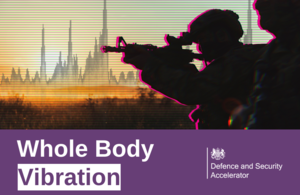£2.5 million available for research and innovation to help Defence better understand whole body vibration
DASA has launched a new Themed Competition that seeks ideas to enhance our understanding of whole body vibration

- DASA has launched a new Themed Competition: Understanding Whole Body Vibration
- Funded by Defence Medical Services and Defence Science and Technology
- Up to £2.5 million in funding available for innovative technologies and ideas that may be used as the basis for further research into whole body vibrations
- The deadline to submit a proposal has extended to midday 24 January 2023
The Defence and Security Accelerator (DASA) is pleased to launch a new Themed Competition, Understanding Whole Body Vibration. Run on behalf of the Defence Medical Services and Defence Science and Technology, this competition seeks to enhance our understanding of whole body vibration (WBV), including its links to injury and effects on performance.
Key dates and funding
£2.5 million (Exc. VAT) funding is available for this Themed Competition. DASA expects to fund between 1-3 proposals.
The deadline to submit a proposal is midday 24 January 2023 (GMT).
Do you have a disruptive idea or concept? Read the full competition document and submit a proposal.
What is whole body vibration?
WBV is defined as vibration transmitted to the whole body, typically from a supporting surface or platform, including vehicles and machinery.
Service personnel across Front Line Commands may experience WBV during training and operations, for example, when occupying wheeled or tracked vehicles that traverse rough terrain, or aboard small boats. Testing new platforms and vehicles also often involves exposure to WBV.
Injuries that can be caused by WBV are not clearly defined and are often non-specific, for example, neck pain, back pain or dizziness.
These symptoms are difficult to attribute directly to specific levels of WBV exposure. Similarly, evidence that details the short-term impact of WBV is often anecdotal. To help Defence better understand WBV, we require detailed, robust epidemiology and experimentation and modelling of WBV effects.
The proposals submitted to this Themed Competition will help address the following outstanding WBV questions, such as:
- what is the scale of injury related to WBV and how does this affect deployability?
- how does vibration cause musculoskeletal injury?
- what happens when vibration and shock are combined with other environmental factors such as heat, cold, noise, altitude, etc.?
- how do we measure WBV exposure at the individual level?
- what are the short-term effects of exposure to WBV and how do they differ for males and females?
Whole Body Vibrations: Challenge areas
This competition has 3 challenge areas.
Challenge 1: Define the size and nature of the problem
This challenge area seeks definitive data on the prevalence and severity of WBV in service personnel working with armoured vehicles or boats.
Ideas that may help solve this challenge area may include:
- machine learning algorithms to mine clinical databases that establish patterns of injury in at risk groups
- mechanistic models that increase our understanding of how WBV causes musculoskeletal injury in males and females and how to predict and prevent future injury
Challenge 2: Quantify exposure to WBV
This challenge area seeks to determine a dose-response relationship between WBV and injury.
Ideas that might help solve this challenge area may include:
-
platform agnostic wearable sensors to evaluate personal exposure to WBV and shock
-
platform instrumentation that can capture and transmit vibration and shock signatures for use in research and development
Challenge 3: Establish the short-term effects of WBV on performance of duties
This challenge area seeks evidence for the effects of WBV exposure on human performance, such as visual tracking ability, cognitive skills, and physical performance.
Ideas that might help solve this challenge area may include:
-
development of military-specific, validated outcome measures that are sensitive to the influence of WBV exposure
-
technology that can reproduce experimental conditions of vibration and shock signatures experienced by individuals across different platforms
For a more detailed breakdown of this themed competition’s challenge areas, read the full competition document.
Webinars
17 November 2022
This webinar will provide more information on the challenge areas and how to submit a proposal. There will also be an opportunity to ask questions in the Q&A. If you would like to get involved, please register on the Eventbrite page.
One-to-one sessions
A series of 15 minute one-to-one teleconference sessions, giving you the opportunity to ask questions.
If you would like to participate, please register for one of the sessions below:
Submit a proposal
Do you have a potentially disruptive idea or concept that will help the Defence Medical Services and Defence Science and Technology understand WBV? Submit your idea and help Defence better protect service personnel from the effects of whole body vibration.
Updates to this page
Published 8 November 2022Last updated 18 January 2023 + show all updates
-
The deadline to submit a proposal has extended to midday 24 January 2023
-
First published.